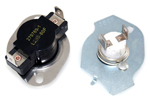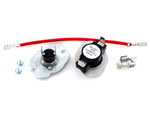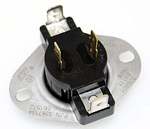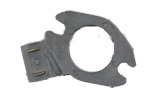How To Open A Clothes Dryer For Repairs
This page provides a description every bit well equally elementary testing methods for each of the parts and components related to an electric dryer. All tests should exist preformed with the dryer unplugged and all wires connected to the part existence tested unplugged.
(Notation: Label all terminals and connecting wires earlier disconnecting them for proper reinstallation.)
Click Here For Gas Dryer Parts & Troubleshooting Help
Thermal Fuse | Hi-Limit Thermostat | Thermal Cut-Off | Cycling Thermostat | Thermostat Heater | Outset Switch |TimerMotor | Temperature Switch | Heating Chemical element | Blower | Belt | Belt Switch | Door Switch | Drum Begetting | Belt Caster | Drum Support | Thermistor | Wet Sensor | Air Menstruum
Thermal Fuse:
 The dryer'south thermal fuse is a not-resettable safety fuse that is designed to break electric contact to the dryer'south heater if the dryer becomes too hot. This fuse will frequently burn out due to clogged dryer ducting or a defective cycling thermostat. The thermal fuse along with a broken door switch is the near mutual crusade of electric dryers that will non start.
The dryer'south thermal fuse is a not-resettable safety fuse that is designed to break electric contact to the dryer'south heater if the dryer becomes too hot. This fuse will frequently burn out due to clogged dryer ducting or a defective cycling thermostat. The thermal fuse along with a broken door switch is the near mutual crusade of electric dryers that will non start.
Test: How-To Test A Dryer Fuse Video.
Disconnect all connecting wires and bank check for continuity across the ii wire contacts. There should exist no resistance measured (a closed circuit, allowing electricity to menses).
Hi-Limit Thermostat:
The hi-limit thermostat is a safety switch that will break electrical contact to the dryer'southward Heating Element if it senses that the dryer has go also hot. The hi-limit thermostat will cycle the dryer's burner or heater off if the ducting has get chock-full blocking proper airflow.
electrical contact to the dryer'southward Heating Element if it senses that the dryer has go also hot. The hi-limit thermostat will cycle the dryer's burner or heater off if the ducting has get chock-full blocking proper airflow.
Symptoms are ordinarily a very short heating cycle with a low drum temperature, or no heat at all. The how-do-you-do-limit thermostat is a fairly reliable dryer component and is rarely the cause of dryer heating problems.
Test: Disconnect all connecting wires and check for continuity across the hi-limit thermostat or sensor set up.
Thermal Cut-Off:
 The dryer's thermal cut-off is similar to the thermal fuse and the high limit thermostat. Information technology will break electrical contact to the dryer's burner or heating element if information technology senses that the dryer is reaching an unsafe temperature. The thermal cut-off is a set up of two thermostats, one of which will non reset once cool. The thermal cut-off needs to exist replaced as a ready. If this set up of dryer parts fails you will need to cheque your dryer and home ducting for bottleneck. And check to brand sure that the dryer's cycling thermostat is operating properly. This type of rubber thermostat does not just fail for no reason. If the non-resetable fuse has blown out, you need to bank check and clean your ducting!
The dryer's thermal cut-off is similar to the thermal fuse and the high limit thermostat. Information technology will break electrical contact to the dryer's burner or heating element if information technology senses that the dryer is reaching an unsafe temperature. The thermal cut-off is a set up of two thermostats, one of which will non reset once cool. The thermal cut-off needs to exist replaced as a ready. If this set up of dryer parts fails you will need to cheque your dryer and home ducting for bottleneck. And check to brand sure that the dryer's cycling thermostat is operating properly. This type of rubber thermostat does not just fail for no reason. If the non-resetable fuse has blown out, you need to bank check and clean your ducting!
Test: Disconnect all connecting wires and check for continuity across the terminals. The thermal cut-off should be closed (allowing current to flow) at room temperature.
Cycling Thermostat:
 The cycling thermostat is responsible for cycling the dryer's heat source on and off to go along a target temperature, ready at the timer or with a temperature selection switch. The dryer's cycling thermostat is a very reliable bi-metal thermostat that rarely fails. This thermostat is normaly closed, allowing electricity to flow freely. When the dryer heats up it will open up, breaking electrical contact to the dryer'southward oestrus source and allowing the pulsate temperature to drop slightly, causing the thermostat to shut again and reenergizing the dryer's oestrus source.
The cycling thermostat is responsible for cycling the dryer's heat source on and off to go along a target temperature, ready at the timer or with a temperature selection switch. The dryer's cycling thermostat is a very reliable bi-metal thermostat that rarely fails. This thermostat is normaly closed, allowing electricity to flow freely. When the dryer heats up it will open up, breaking electrical contact to the dryer'southward oestrus source and allowing the pulsate temperature to drop slightly, causing the thermostat to shut again and reenergizing the dryer's oestrus source.
The thermostat's operating temperature range is identified on the function with an "L" followed past the temperature. For example, L130 would open up (cycling the dryer's heat off) at 130ºF. A dash followed past another number, for example L155-10, would mean that the dryer thermostat would close afterwards having cooled 10ºF. Faulty cycling thermostat symptoms could take the grade of very high dryer temperatures, blown out thermal fuses, or no heat. The cycling thermostat works in connection with a thermostat heater to achieve lower dryer temperatures, such as low and medium heat settings.
Exam: Remove all connecting wires and test for continuity. There should be no resistance measured when the dryer is cool (a airtight circuit, allowing electricity to flow). Cycling temperatures tin be roughly calculated with a meat thermometer held side by side to the dryer'due south exhaust duct. As the dryer rut source is cycled on and off, temperatures can be observed.
Dryer Repair Videos
Thermostat Heater: 
The thermostat heater is frequently located within the cycling thermostat. However, it may sometimes be a separate component mounted to the dryer'due south cycling thermostat. Depending on the dryer's temperature setting, more than or less voltage is supplied to this heater. Low settings supply more than voltage and create more heat, while medium settings supply slightly less voltage, generating less heat. High heat settings will non energize the thermostat heater at all. In this way the thermostat is tricked into thinking that the dryer is hotter than information technology actually is, so it opens at a lower drum temperature. Bug with this system can occur when the temperature selection switch fails to send the proper corporeality of voltage to the thermostat heater, or the heater itself fails to rut the thermostat.
Test: Remove all connecting wires and cheque for resistance across the heater contacts. Approximately 3200-4000 ohms of resistance should be measured.
Source: https://applianceassistant.com/appliance-repair/dryer-repair/how-electric-dryer-parts-work/
Posted by: palmersquam1970.blogspot.com


0 Response to "How To Open A Clothes Dryer For Repairs"
Post a Comment